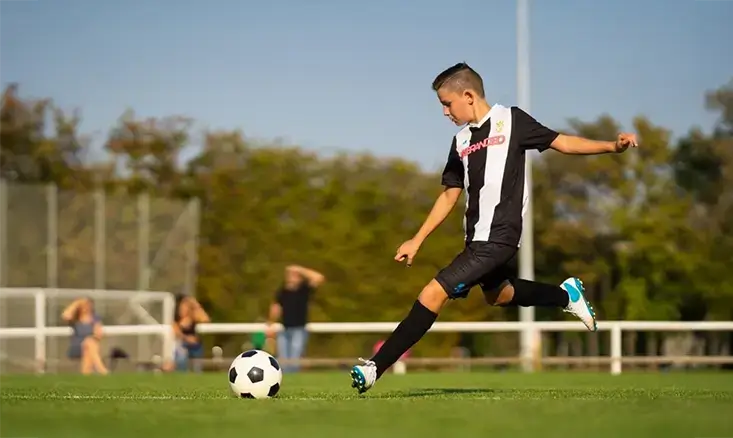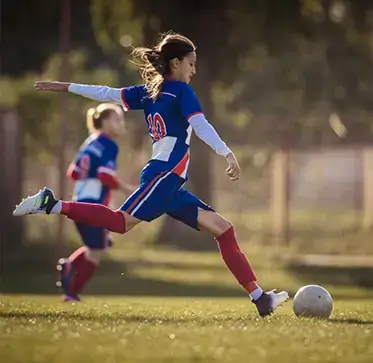CRFC BLOGS
LATEST BLOGS & NEWSLETTERS
Mastering Youth Soccer Indirect Free Kick Rules
Youth soccer is about learning how to play the game and understanding its rules and strategies. Players, coaches, and parents must grasp the essential elements of youth soccer indirect free-kick rules. This article explains these rules, highlights the differences between direct and indirect kicks, details what causes an indirect kick in youth soccer, and offers practical tips for training and gameplay.
Understanding Youth Soccer Rules: Direct vs Indirect Kick
Direct vs. Indirect Free Kick Explained
-
Direct Free Kick
A type of kick from which a player can score directly without the ball touching another player. Typically awarded for serious violations like tripping, pushing, or handling the ball deliberately.
-
Indirect Free Kick
This type of kick requires that the ball be touched by another player (teammate or opponent) before a goal can be scored. Indirect kicks are awarded for less severe violations and are common in youth soccer as teaching tools.

What Causes an Indirect Kick in Youth Soccer?
Knowing what causes an indirect kick in youth soccer can be vital during a match. While some players may only focus on scoring or defense, being aware of the violations that result in an indirect kick can change the game’s flow.
Common Violations Leading to Indirect Free Kicks
Dangerous Play
This includes high kicks, trying to play the ball while on the ground, or actions that could harm another player.
Impeding an Opponent
When a player intentionally blocks another’s path without attempting to play the ball.
Goalkeeper Violations:
Holding the ball for too long
Youth goalkeepers are allowed to control the ball for up to six seconds. Exceeding this time results in an indirect free kick for the opposing team.
Handling a back-pass
If a goalkeeper touches the ball with their hands after it has been deliberately passed to them by a teammate, an indirect kick is awarded.
Double touch
If a goalkeeper picks up the ball again after releasing it before another player has touched it, an indirect free kick can be given.
These violations may not carry the weight of a penalty kick but can be decisive, especially in tightly contested youth matches.

Youth Soccer Indirect Kick in the Box
An indirect free kick in the box is less common but carries significant importance. When awarded, it typically results from a goalkeeper violation or another non-contact foul. The attacking team sets up inside the penalty area, with defenders lined up on the goal line to block the shot.
Executing an indirect kick within the box requires careful coordination. For the defending team, staying composed and organized is critical to blocking or deflecting the shot.
Referee Signals for Indirect Free Kicks
Recognizing a referee’s signal is just as important as understanding the rules. For an indirect free kick, referees raise an arm above their head and keep it raised until the ball touches another player. This simple signal is crucial for indicating that a direct goal is not possible until another player is involved.
Why Signals Matter
Referee signals help players adapt quickly and plan their next move. Coaches should educate players to pay attention to these signals so they can act accordingly. In a high-pressure game, knowing the difference between direct and indirect free kick signals can prevent costly mistakes.
Executing an Indirect Free Kick Outside the Box for Youth Soccer
Best Practices for Indirect Free Kicks
-
Quick Execution
Catching the opposing team off guard with a fast restart can create scoring opportunities.
-
Positioning
Players should know where to position themselves to receive a pass or make a quick touch to allow a shot on goal.
-
Effective Communication
Clear communication between teammates helps ensure everyone knows their role in the play.

Strategic Importance of Indirect Free Kicks
Training and Practice Techniques
To improve execution, coaches should create specific drills that mimic match conditions. For example:-
Two-Touch Drills
Players practice touching the ball once to set up a pass or shot, focusing on precision and speed.
-
Communication Exercises
Players call out who will make the next move, promoting teamwork and ensuring smooth execution.
Building Game Intelligence
Learning to recognize and exploit situations involving an indirect free kick for youth soccer is part of developing game intelligence. Players who understand when and how to use an indirect free kick can catch defenders off balance and open up scoring chances. Coaches can teach players to spot when the opposing team is out of position and make quick, strategic decisions.Tips for Coaches and Parents
Building Rule Awareness
Parents and coaches should encourage young players to become familiar with the rules. Understanding what an indirect free kick is, what it means when the referee signals for one, and how to react quickly helps build confidence and prevents confusion during games.Guidance for Effective Practice
To make practice sessions more engaging:-
Simulate Real Scenarios
Incorporate practice games that include both direct and indirect free-kick situations.
-
Review Game Footage
Watching clips of professional or older youth games can help young players see examples of indirect free kicks and understand the strategic thinking involved.
-
Interactive Q&A
End practice sessions with a brief Q&A where players can ask about scenarios involving youth soccer indirect kick rules. This helps build collaborative understanding.

Conclusion
Mastering youth soccer indirect free-kick rules goes beyond knowing how to make a kick. It’s about learning the game’s flow, making quick decisions, and working effectively as a team. When players, coaches, and parents understand what causes an indirect kick in youth soccer and how to handle it, the result is a more strategic, informed, and confident approach to the game.
FAQs
What is an indirect free kick in youth soccer?
An indirect free kick in youth soccer is a type of kick where the ball must touch another player before a goal can be scored. It’s awarded for less severe violations like dangerous play or goalkeeper violations.
What causes an indirect kick in youth soccer?
Common causes include dangerous play, obstruction, offside violations, and certain goalkeeper violations, such as handling a deliberate back-pass or holding the ball for too long.
How does the referee signal an indirect free kick?
The referee raises an arm above their head and keeps it up until the ball is touched by another player or goes out of play. This indicates that a direct shot on goal is not allowed.
Can you score directly from an indirect free kick in youth soccer?
No, you cannot score directly from an indirect free kick. The ball must touch another player before entering the goal for it to count.
What is an indirect free kick in the box?
An indirect free kick in the box is awarded for non-penalty violations by the defending team within their penalty area. The ball must still touch another player before a goal can be scored.

Did you find this useful?


